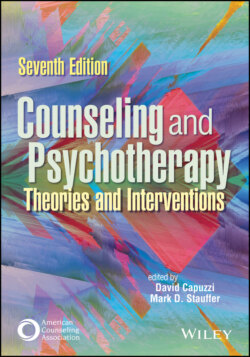Читать книгу Counseling and Psychotherapy - Группа авторов - Страница 25
Chapter 1
Helping Relationships and Theoretical Foundations for Counseling and Psychotherapy
ОглавлениеDavid Capuzzi, Mark D. Stauffer, and Rhemma D. Payne
Studying theories of individual counseling and psychotherapy is simultaneously challenging and enlightening and usually marks the beginning of a long-term journey to develop one’s personal theory of counseling. The process is challenging as there are so many options from which to choose to guide one’s practice because theories, though different conceptually, all have one thing in common—the importance of developing a therapeutic alliance with a client. Through the counseling relationship and the therapeutic alliance that develops, client change occurs. Although the creation of this relationship is not the end goal of the process, it certainly is the means by which goals are met. It serves as the framework within which effective helping takes place. In addition, even though use of each theory is dependent on the helping relationship, each theory presents a different model for case conceptualization and treatment planning and uses a variation of aligned techniques and interventions.
Most beginning counselors experience doubts and insecurities about how theories help counselors navigate their work with clients, and more specifically, how they will use theories in their own practice. What are they nervous about in their study and application of counseling theories? Some counselors have an overwhelming sense that they must quickly or eventually choose one theory to work from and then faithfully hold to it (in a limited and an uncreative way). Others worry that working from any theory will box in or limit their view of the client. How can one theory capture a person’s lived experience? How can one theory be used across multiple clients with diverse cultural intersectionalities? Intersectionality means that “different aspects of one’s identity are not exclusive of each other, but rather inform the construction of each other in reciprocal ways” (Brinkman & Donahue, 2020, p. 109). These questions and others like them must be kept alive by counselors in their living practice. At the same time, use of theory is intended not to limit who a client is but rather to help a client change through a specific path or lens. This is one path among possible helpful paths.
Rather than thinking that there is only one theory that can help a client, consider that therapy from multiple theories may help the same client. The first question may be, are certain theories more or less appropriate given the circumstances and the client’s cultural intersectionalities? Second, how do those relate to how you, as a counselor, are able to work with clients? Examine the mechanism for how a theory creates change in a client’s life (e.g., through insight, behaviors, emotion, catharsis, or cognitions) and realize that success through one mechanism leads to changes in other aspects because growth is systemically interdependent. Thus, a transformative existential insight in therapy will likely cause secondary behavioral, relational, emotional, and systemic changes. Can you think of how you created a change in your life in one area, such as your thoughts, behaviors, relations, or in your bonding with others, that then created a ripple of secondary changes, and then tertiary changes? Adept counselors clearly understand the range of theories, mechanisms of change, and advantages to different systems of therapy even if they have a theoretical focus. Additionally, students of counseling often think that they are coming to the helping profession without personal, cultural, and familial notions of helping. Without thorough examination of different theories and techniques of helping, they may develop a therapeutic relationship and simply default to the ideas of helping from their family of origin. These are not necessarily wrong; however, mastery as well as helping diverse clients goes beyond a counselor’s default as a professional.
Some counselors-in-training initially try to apply attending, building rapport, and helping skills without a helping theory and find themselves lost in medium-and long-term work with clients. The study of theories will often be at the beginning of coursework for necessary growth and understanding throughout the program, but often it is taught before one works with clients, which makes the application of theory harder to understand. As a suggestion, they should review this book during their program as well as to guide their practicum and internship; in the meantime, they should examine how individuals, families, and groups change in their lives, and, of course, watch counseling videos from different theoretical lenses with current and culturally relevant scenarios. In this book, we have tried to make it as easy as possible to learn about available options to guide counselors’ and therapists’ preparation and actual work with clients. Because this is a foundations text for broad synthesis and introduction to various theories, we encourage counselors and therapists to find landmark resources, current adaptations, and new research to deepen their work in the theories they pursue.
Notice that each chapter from Chapters 2 through 17 addresses the theory under consideration using the same headings and subheadings; this enables the reader to compare concepts, areas of focus for follow-up when developing treatment plans, and the goals and techniques used to achieve preferred outcomes for clients. More important, all stages of work with a client must be theoretically aligned, even if there are core dimensions to a helping relationship. For example, viewing a case from a psychodynamic lens and then using a cognitive behavioral strategy or intervention will not work, let alone make sense. We will introduce how theories are integrated, because many are harmonious and the way that the case is conceptualized may allow for various theoretical strategies.
Before we turn attention to integration, much of this chapter will focus on factors that affect the helping relationship: definitions and descriptions, stages, core conditions, and strategies. In addition, we discuss multicultural and social/cultural orientations as a necessary element of counseling and psychotherapy from theoretical conceptualization to intervention.
